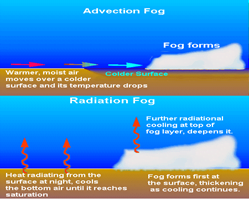Environment & Ecology, Geography
Context: Recently, dense fog has enveloped north-western India, including Delhi, Punjab, Haryana, parts of Uttar Pradesh, and parts of Rajasthan.
About Formation of Fog:

Formation:
- With the land surface cooling down at night, the air close to the surface also cools down.
- Since cooler air cannot hold as much moisture as warm air, the water vapour in the air condenses to form fog.
- Fog begins to form in the early hours of the morning, when the temperature is at its lowest.
Favourable Conditions:
- The presence of moisture and a fall in the temperature are key factors for the formation of fog.
- Fog can have “high spatial variability”, and its intensity can depend on factors like humidity, wind, and temperature.
- Areas near water bodies, for instance, may see denser fog because of the higher humidity.
- The Indo Gangetic Plain is most vulnerable to fog occurrences, with major, weeks-long spells of dense fog in the months of December and January.
Types of fog
- Advection fog is larger in scale for both area covered and duration.
- It forms when warm, moist air passes over a cool surface, causing water vapour to condense.
- It occurs where warm tropical air meets cool ocean water.
- If wind blows in right direction, sea fog is transported over coastal land areas.
- Valley fog is formed due to mountains preventing dense air from escaping.
- Fog gets trapped at bottom of valley which lasts for several days.
- Freezing fog is result of liquid droplets freezing on solid surfaces.
- It occurs at Cloud-covered mountaintops.
- They are not found in Indo Gangetic Plain.
Conditions Favouring Fog over North-western India
Decreasing Temperature:
- Temperatures have begun to dip over north-western India.
- Recently, Delhi recorded the lowest minimum temperature of the season so far — 6 degrees Celsius.
- Cold wave conditions, in which the minimum temperature is significantly lower than normal, have been recorded recently over Punjab, Haryana, and parts of Rajasthan.
Dense Fog:
- The fall in temperature along with moisture and light winds over the Indo Gangetic Plain has resulted in dense fog over the region.
Effect of Western disturbances:
- Western disturbances, which are storms that originate in the Mediterranean Sea, bring moisture-bearing winds to northwest India.
- This can result in increased moisture levels over the region.
- In the absence of western disturbances, local moisture sources like water vapor from rivers and soil moisture can also cause fog.
Link between Pollution Levels and Fog

More Fog at Polluted Places:
- According to the India Meteorological Department (IMD), Delhi being more polluted, records more fog days compared to others.
Fog increases Pollution:
- As temperature declines, local wind speed also falls. The inversion layer comes down and vertical mixing reduces.
- This results in fog formation and particulate matter hangs on the boundary layer, increasing pollution levels.
- Recently, Delhi recorded a spike in pollution levels with AQI in the ‘severe’ category.
Rapid Growth of Pollutants:
- Advection fog episodes last longer and secondary particulate formation then begins leading to rapid build-up of pollutants.
Source: Indian Express
Previous Year Questions
Q.1) Consider the following statements:
- High clouds primarily reflect solar radiation and cool the surface of the Earth.
- Low clouds have a high absorption of infrared radiation emanating from the Earth’s surface and thus cause warming effect.
Which of the statements given above is/are correct? (2022)
- 1 only
- 2 only
- Both 1 and 2
- Neither 1 nor 2
Q.2) Why are dewdrops not formed on a cloudy night? (2019)
- Clouds absorb the radiation released from the Earth’s surface.
- Clouds reflect back the Earth’s radiation.
- The Earth’s surface would have a low temperature on cloudy nights.
- Clouds deflect the blowing wind to ground level.














